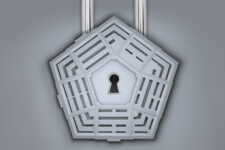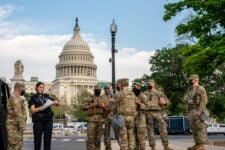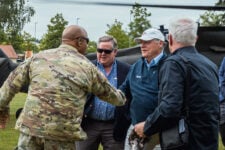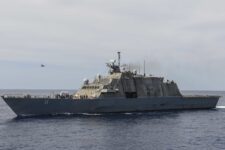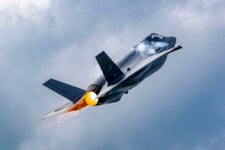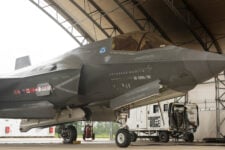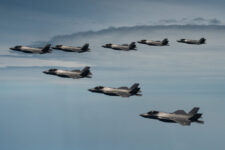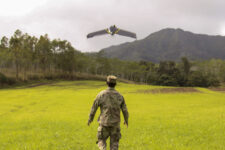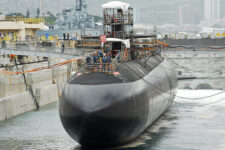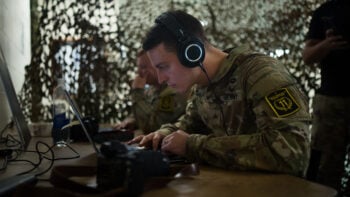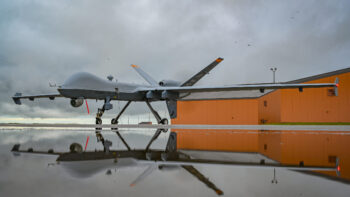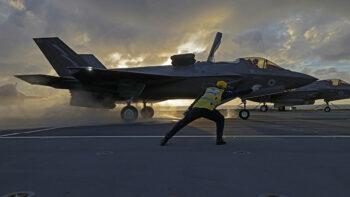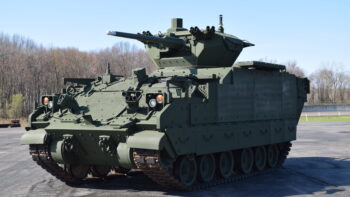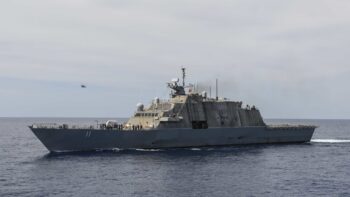
United States Representative Rob Wittman (center) of Virginia shakes the hand of Brig. Gen. Forrest Poole (right) on Marine Corps Base Quantico, Virginia, Sept. 10, 2021. (U.S. Marine Corps photo by Cpl. Scott Jenkins)
WASHINGTON — The Department of Defense has been full steam ahead on its concept of networked operations, Combined Joint All Domain Command and Control, or CJADC2, for several years. But an influential member of Congress now thinks the Pentagon needs to take a breath, slow down and reassess the way forward.
In fact, Rep. Rob Wittman said he now believes that “What the Pentagon needs to do is, they need to narrow the scope of what they want to try to accomplish initially with CJADC2” if the overall effort is to succeed.
Wittman, a Virginia Republican who is the vice chairman of the House Armed Services Committee and leads the Tactical Air and Land Forces Subcommittee, made that initial comment during a June 12 event at the Hudson Institute. When asked about his comments the following day, Wittman emphasized that while CJADC2 is the right approach, he’s worried that the department’s aims have become too broad without having the basics down.
“I think [the Pentagon said] we wanted CJADC2 to do all these things: We wanted it to gather data, we wanted it to essentially annotate data, we wanted it to be able to get it in a targetable form. We wanted to get it out to all these platforms, we wanted to make sure that it was used for decision making. We wanted it to be used for targeting. There are a lot of things that they wanted to do. And when the scope is that big, it’s hard to have one thing to accomplish all of that,” he said on the sidelines of Applied Intuitions’ Nexus 24 event.
“I think what they’re trying to do right now is to say, maybe we need to take a step back,” he said.
CJADC2 — formerly JADC2 — has been the dominant concept for the Pentagon in recent years, even as key leaders have struggled on and off to articulate what it actually is. At its core, the idea is to create a system that takes critical information from anywhere in the world, across service lines, and connect it with decision makers at rapid speed — or, as the Pentagon likes to say, to “connect sensors to shooters.”
However, different military branches are pursuing their own CJADC2 initiatives, each prioritizing their own connectivity needs. The Air Force has its Battle Network that reaches through outer space, the Navy is working on its secretive Project Overmatch and the Army’s effort is called Project Convergence. This has led to past concern there’s not enough “jointness” in the joint fighting concept.
While DoD leaders have recently expressed optimism that they are getting ahold of the joint portion of the concept, the piecemeal approach means there was never a core to build off of, something Wittman highlighted as a concern.
“You know, you can build the greatest house in the world. But if you don’t build a really strong foundation, all of a sudden you look at [it] and go man, this house is going to tumble in because we didn’t do the early work the right way,” Wittman said. “So really what the Pentagon needs to focus on, is that foundational work to say, let’s get the foundation of CJDAC2 right, and take that first step.”
What does that foundation look like? For Wittman, it starts with really working out the nuts and bolts of how to take the infamous tsunami of data that the Pentagon brings in every day and create a system that can annotate that data in an automated fashion.
“I think it’s within the realm of data, of data annotation, synthetic data annotation, and then getting that targeting data out to everybody,” he said, later concluding, “I think the Pentagon can do this, [but] I think they’re understanding that they do have to scope this down.”
The Congressman also expressed concern about the size of the “pipes” the information is flowing through. Both at Hudson and the Nexus event, he raised concerns that Link 16 is not able to carry the kind of bandwidth needed for modern ISR, particularly video feeds.
“The question is, if you’re going to do CJADC2, [DoD] maybe ought to build the pipe bigger first, before you look at all this enabling software and things that need to be done,” he said at Hudson.
